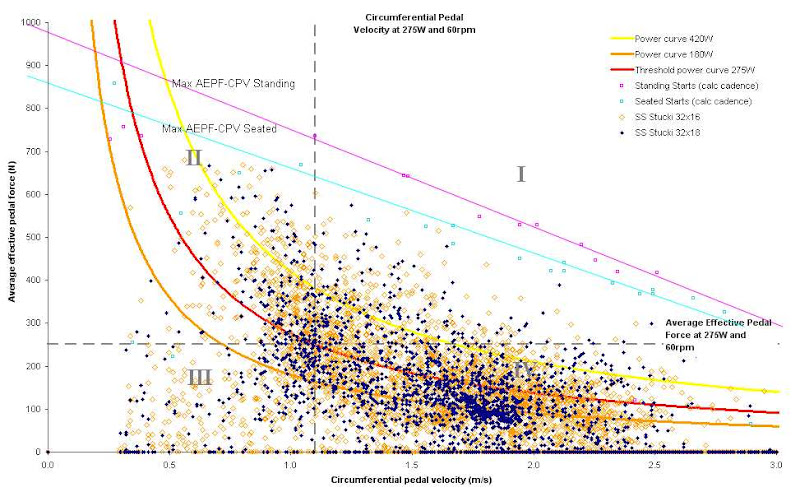Pure single speeders are a passionate bunch. After doing a bit of lurking on the mtbr SS forum and observing the SS related comments here it's obvious the top reasons SSers do what they do come from the heart. As it should be.
Perhaps I will find that happy SS nirvana in time, but right now I'm a geared rider having fun on a SS. It's my analytical nature that has me analyzing the demands of SS right now so that I can make a better plan to train for a SS event or two (or three or... ;). Nirvana is directly proportional to speed, 'tis a proven fact - so this quest is worthwhile.
There are two obvious paths to go when considering how to train for SS: target specific aspects of SSing (on the road or MTB), or just go ride your SS. On the geary, my long-standing paradox has been that to really improve, I have to do specific work - intervals and the like - usually on the road but not always. So, I'm going to choose the former cause it's worked best for me in the past. SSing 6 days/week might not be sustainable for me, it's hard stuff!
So then, what are the aspects of SSing that need special attention? Power Tap to the rescue....the first step is to install the PT on the SS, go ride, then take a look at the ride data through the various tools available. The most valuable of these has been Quadrant Analysis developed by Andrew Coggan. Chances are that if you train with power you know the good Doc.
QA simplified: every data point in a file represents a power output and cadence. Knowing this in addition to the crank length the data is further broken down to the constituents of power - pedal speed (CPV) and average effective pedal force (AEPF). In lay terms, how hard you are pushing on the pedals and how fast your feet are moving. Crosshairs are then drawn with the intersection at the pedal force and cadence that represent what is normally done at threshold power. This divides the plot into 4 quadrants with these relative characteristics.
- I: high power, high cadence
- II: high power, low cadence
- III: low power, low cadence
- IV: low power, high cadence
Obviously, SS requires one to push darn hard at low cadences and really fast when spun out. But where are the limits? And are they trainable?? Key questions in my quest. I'll be sharing my random thoughts along the way of this process. They evolve daily ;) But first, let's look at that QA plot again and see what it can tell us. Note: 57 is not my preferred cadence so the QA crosshairs are misaligned in this plot...preferred cadence is about 96 so just about all points are in QII in reality.

There is a lot going on here. Yea, it'd make a nice tattoo M but I'm not sure I have the bicep to pull it off so I'll stick to the geeky stuff ;) The points here are from two different rides, one on a 32x18, the other on a 32x16. The route is rolling, some steep short climbs, some fast descents. Overgeared and undergeard, like every SS ride I've done. The pace was moderate (not hard), but where it tilt's up I went hard enough so as not to walk. IOW, L6 power levels.
There is also some test data from 2 types of efforts: maximal standing starts, one set is done seated, the other done standing. It turns out the maximal AEPF-CPV relationship is linear, so getting some good points along this line allows one to extrapolate the maximal curve out to max force and max pedal speed. That's what the 2 straight lines represent. Those lines are the highest pedal forces I can achieve for any given pedal speed - I wanted to establish these lines to see how close SS low cadence stuff came to maximal.
That's enough background. Here are some things I see:
- normal cadence range for SSing is 45-130.
- typical pedal forces go up 550 N. In geared riding they rarely go over 275 N (I'll post a comparison geared QA at some point) and for the most part are below 225!
- pedal forces occasionally bump right up against that maximal force/cadence line
- pedal forces routinely go to (and above) 75% of max AEPF in a moderately paced SS ride. This is in comparison to ~ 25-30% in a geared ride.
- the ability to put out power at low and high cadences are equally important (but have very different demands!)
Finally, note the 3 iso-power curves - red, yellow, and orange. In particular, note how they tilt rapidly upward on the left side. Where they are horizontal on the right, small changes in pedal force have big effects on power output. But on the left, it takes huge changes in pedal force to alter power output, or from another angle, at very low cadences it takes huge AEPF to put out any sort of power. In theory, at a cadence of 20ish I can do no better than threshold power no matter how hard I try. So for anyone, no matter how "strong" you are, being overgeared beyond some point is going to reduce your power on the climbs. Physics in action.
Did I miss anything? Requirements of the soul perhaps?? They don't show up in QA ;)
This weekend I'll be doing some longer rides with the SS. I'm curious to see what those data sets will say about sustainability of these higher pedal forces over the long haul.
Happy Thanksgiving! Stuff yourself silly as is our custom...gives cyclists a reason to ride more.